
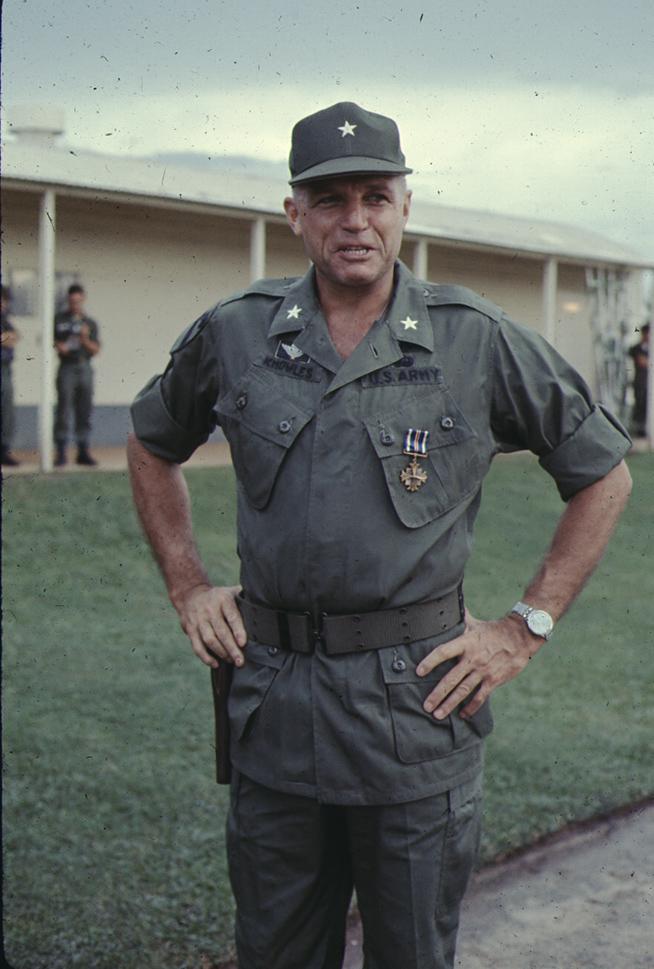
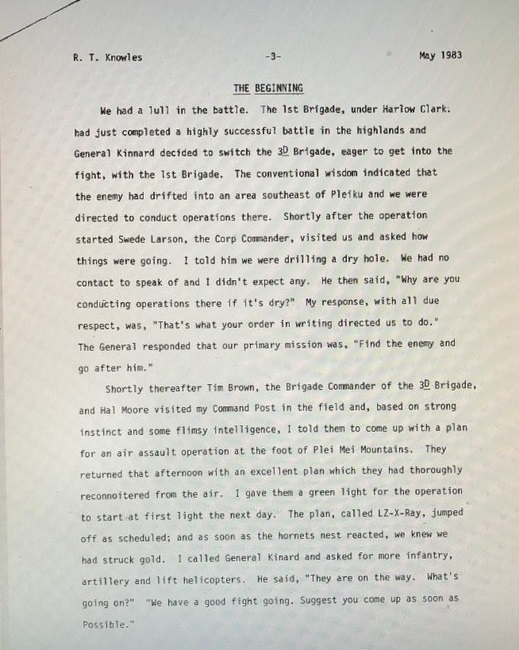
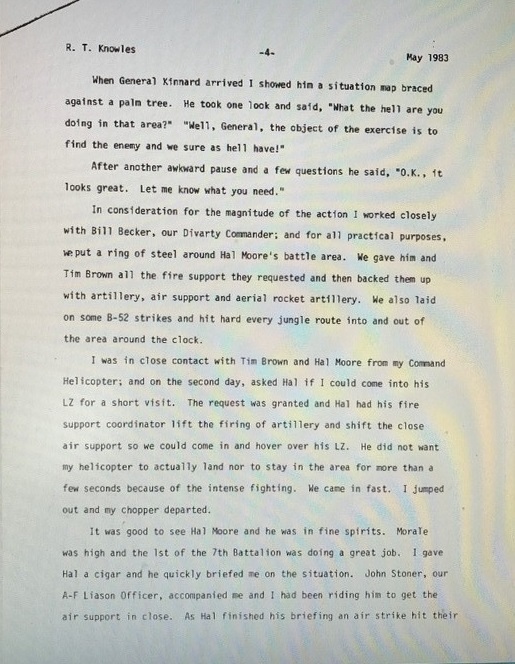
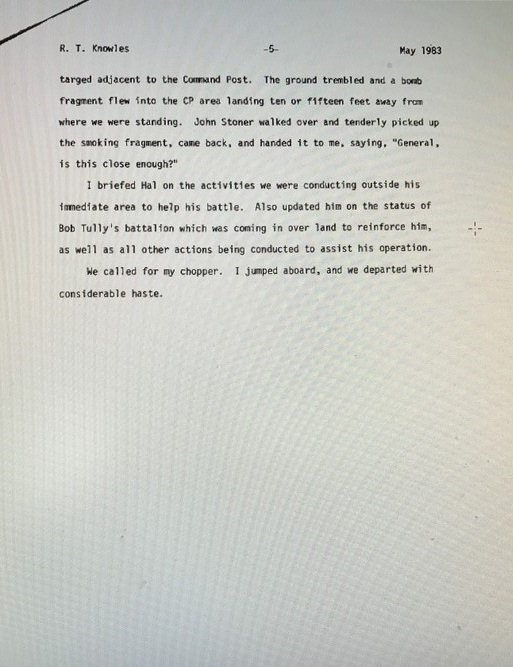
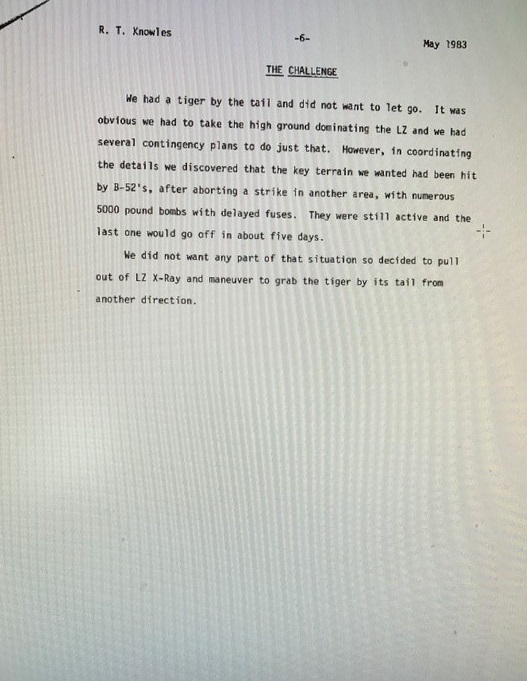
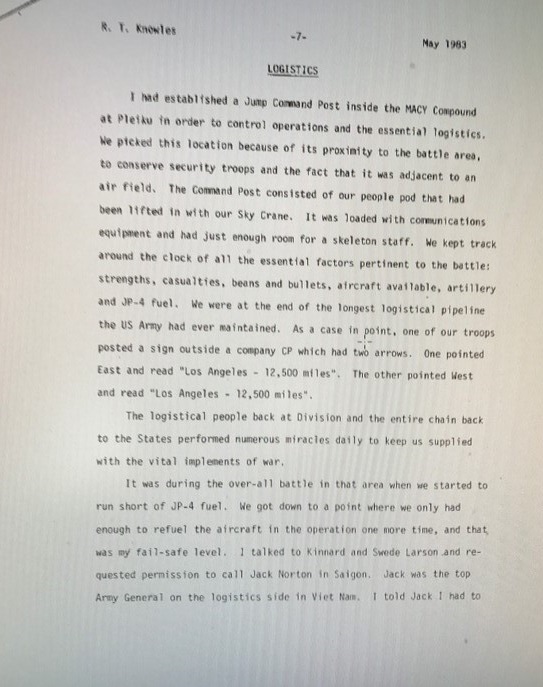

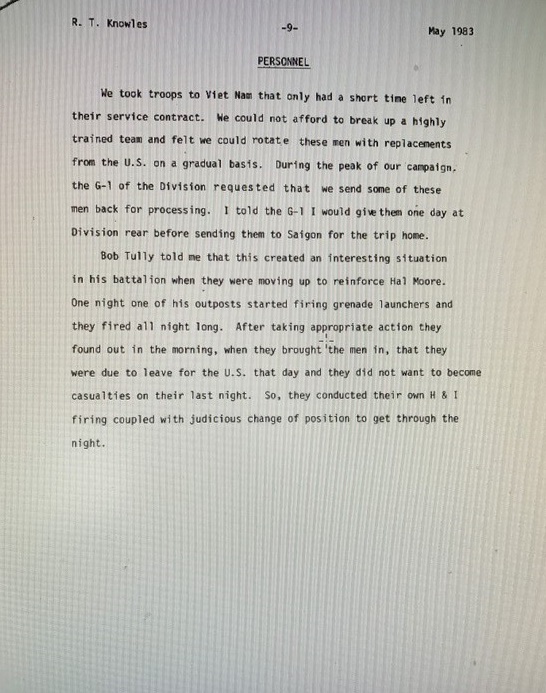

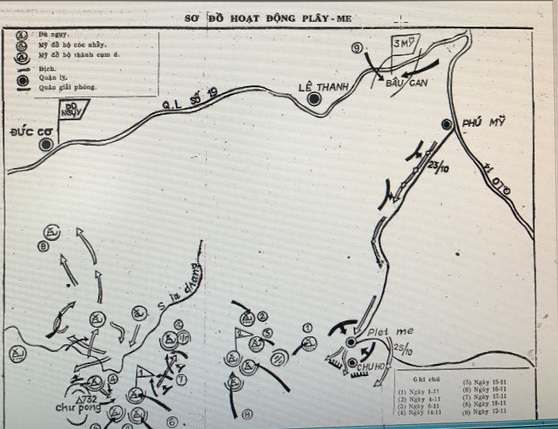
(27180000000, Richard T. Knowles Collection, The Vietnam Center and Archive, Texas Tech University)
Lt. Gen. Richard Knowles wrote-up his narrative of the LZ X-Ray Battle in May 1983 at the request of Lt. General Hal Moore who was seeking help in writing his upcoming book, We Were Soldiers Once … And Young co-authored by Joseph Galloway. Moore’s book was published in 1992. Knowles sent his narrative to Moore with a cover letter dated 20 June 1983.
Knowles’s narrative remained unknown to the general public until August 2017, at which date it was released and made available for research at the Vietnam Center and Archive, Texas University, in Richard T. Knowles Collection (2718)
In his narrative, Knowles expresses quite a few pertinent points of view that are unique and eye-opening.
- “Why are you conducting operation there if the hole is dry?”
By relating this dialogue with Lt. Gen. Swede Larsen, IFFV Commander, Knowles indicates that the idea and the planning of the LZ X-Ray Operation was not his, but came from higher up and relayed to him by Larsen.
- “Jump command post”.
Knowles specifies the command post that was established within the MAVC compound in the ARVN
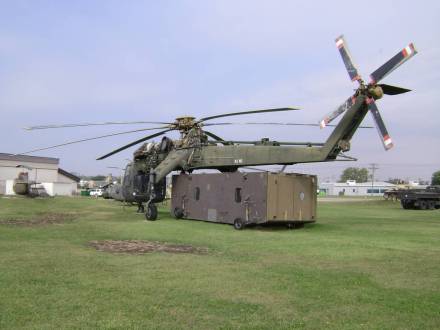 II Corps Headquarters in Pleiku was not a full division forward command post, but rather a “jump command post” consisting of “a skeleton staff” that fitted in a pod. Its main purpose was to assist the ARVN II Corps Command in the execution of the Long Reach Operation in terms of controlling the troop operations and the essential logistics. The orders dictating the Air Cavalry troop maneuvers, as it is indicated in the Pleiku Campaign, were relayed from the ARVN II Corps Command to Knowles through General Larsen, IFFV Commander, so as not to give the appearance that Knowles was under the command of General Vinh Loc.
II Corps Headquarters in Pleiku was not a full division forward command post, but rather a “jump command post” consisting of “a skeleton staff” that fitted in a pod. Its main purpose was to assist the ARVN II Corps Command in the execution of the Long Reach Operation in terms of controlling the troop operations and the essential logistics. The orders dictating the Air Cavalry troop maneuvers, as it is indicated in the Pleiku Campaign, were relayed from the ARVN II Corps Command to Knowles through General Larsen, IFFV Commander, so as not to give the appearance that Knowles was under the command of General Vinh Loc.
Knowles' jump command post was established next to the ARVN II Corps Command and functioned as the American component in the joint ARVN-US operation in which the ARVN side was in charge of the concepts of operation and intelligence while the US side took care of the control of troops and logistics.
- “Steel ring”.
Hal Moore’s 1/7 Air Cavalry Battalion once inserted at LZ X-Ray was heavily protected by “a ring of steel” put up by the Division Artillery. Furthermore, Knowles had “every route into and out of the area hit hard around the clock” - to interdict NVA troops of the 32nd and 33rd to come in the area - and reinforced the 1/7 Air Cavalry Battalion with the 2/7 and 2/5 to counter the NVA 7th and 9th Battalions belonging to the 66th Regiment as well as to cover the withdrawal of the 1/7 set for November 16.
The 1/7 Air Cavalry Battalion was at all times safe, allowing Knowles to check in at the LZ X-Ray during the heat of the battle in the afternoon of November 15, as well as Colonel Tim Brown in the morning of the same day.
The reason for Knowles' visit was to assess the situation and see if Moore was willing and able to handle the withdrawal of his battalion. (Moore and Galloway, page 210)
That morning, at 9:30 am, Brown landed at LZ X-Ray to establish a forward brigade command post to execute the withdrawal of Moore's 1/7 Air Cavalry Battalion. But Moore refused to relinquish the command of his battalion. (Moore and Galloway, page 202)
Around midnight, Moore was ordered to report to Saigon the next morning to brief General Westmoreland and his staff about the battle. Moore vehemently objected to the order. (Moore and Galloway, page 216)
Before having the 1/7 Air Cavalry Battalion inserted at LZ X-Ray, Knowles was aware that the NVA 66th Regiment, whose headquarters was located nearby the insertion point, did not have its battalion of 14.5mm twin-barrel anti-aircraft guns and its battalion of 120mm mortars, which were both en route down the infiltration trail and scheduled to meet the 66th Regiment at Pleime, for the attack. These two battalions, if present at LZ X-Ray with their heavy guns and mortars positionned on the hillsides overlooking the landing zone, would have caused havoc to the troop insertion.
It is obvious that the 1/7 Air Cavalry Battalion was inserted at LZ X-Ray to establish a presence as a diversionary ploy and not an attack threat.
- “Mad minute”.
Knowles gives an explanation for the Harassment and Interdiction (H&I) night firing conducted by one outpost of Bob Tully’s 2/5 Air Cavalry Battalion: the men of that outpost “were due to leave for the U.S. that day and they did not want to become casualties on their last night".
In the cover letter, Knowles advised Hal Moore to include details of his battalion’s “Mad Minute” in his coming book.
- “Grab the tiger by its tail”.
Knowles reveals the purpose for the insertion of the Air Cavalry troops was to “grab the tiger by its tail” and to hit its head with B-52 airstrikes from November 15 to 16. He also explains the reason for pulling out of LZ X-Ray on November 17 and moving to LZ Albany was “to grab the tiger by its tail from another direction” and continued to hit head its with B-52 bombs from November 17 to 20.

The expression “Grab the tiger by its tail” used by Knowles has the imprint of Colonel Hieu, II Corps Chief of Staff, who coined the name given to the operation conducted by the 1st Air Cavalry, Long Reach - in Vietnamese Trường Chinh (Pleime, Trận Chiến Lịch Sử, page 101) - and who used a similar expression to describe a tactic used by a NVA battalion in its attempt to ambush an ARVN Airborne battalion later in the campaign: kiềm thủ kích vĩ , literally hold head kick ass (Pleime, Trận Chiến Lịch Sử, page 132) .
Nguyen Van Tin
15 October 2017
- Hành Quân Pleime-Chuprong Oanh Tập B-52
- Việc Xử Dụng Oanh Kích B-52 Trong Chiến Dịch Ia Drang, Bí Mật Quân Sự Giữ Kín Nhất của Tướng Westmoreland
- Air War Over Pleime-Chupong
- Arc Light over Chu Pong Operation
- Catching a Thief Tactic in Pleime Campaign
- Pleime/Chupong Campaign Destroying B3 Field Front Base
- The Uniqueness in Pleime Counteroffensive Operational Concept
- Pleime Counteroffensive into Chupong Iadrang Complex
- The Unfolding of Strategic and Tactical Moves of Pleime Campaign
- Battle of Pleime
- The Truth about the Pleime Battle
- Intelligence Gathering at Ia Drang
- Intelligence, the Key Factor in the Pleime Campaign's Victory
- Roll Call of Combatants at Pleime-Chupong-Iadrang Battlefront
- "Victory at Pleime" ?
- Tactical Moves in Pleime Battle
- Kung Fu Tactics at Pleime Campaign
- Various Diversionary Moves in Support of Arc Lite Strike in Pleime Counteroffensive
- What if there was no master plan for Pleime Counteroffensive?
- Pleime/Chupong Campaign Destroying B3 Field Front Base
- A Few Things You Should Know about Pleime-Iadrang Campaign
- Things the VC Don't Want People To Know at Pleime Battle
- Reviewing "Why Pleime"
- Review of "Intelligence Aspects at Pleime_Chupong Campaign"
- Perplexing Maneuvers at Pleime-Chupong-Iadrang You Might Be Attempted to Question
- A Bird’s-Eye-View of Pleime Campaign
- Operation Dan Thang 21
- US Air Force’s Roles in Pleime Campaign
- Arc Lite Operation Planning and Execution in Pleime Offensive
- A Doctrinal Lesson on the Use of Arc Lite in Pleime Counteroffensive
- Command and Control of Arc Light Strike at Chupong-Iadrang
- A Military Genius in Action at Pleime-Chupong-Iadrang Battlefront
- Command and Control Skills in Pleime Campaign
- Behind-the-scenes Activities at Various Allied Headquarters During Pleime Campaign
- The Two Principals Players Of Pleime Chess Game
- Pleime Battle's Diary
- Pleime Campaign and Pleiku Campaign
- A New Look at Ia Drang
- Hành Quân Long Reach
- LZ X-Ray Battle (General Knowles)
- My Contributions to the Battle of Ia Drang in Wikipedia
- Operation LZ X-Ray
- Colonel Hal Moore’s Self-Aggrandizement in “We Were Soldiers Once ... and Young”
- Colonel Hal Moore Misunderstood his Mission at the Ia Drang Battle
- What Historians Failed to Tell About the Battle at LZ X-Ray
- Hal Moore and 1/7th Air Cavalry Battalion's Real Mission at LZ X-Ray
- Two Different Narrations of LZ X-Ray Battle by II Corps
- Ia Drang Valley Battle? Which One?
- LTC Hal Moore Summoned to a Woodshed Session?
- Colonel Hieu's Operational Concept for LZ X-Ray
- LZ Albany Battle - Chinese Advisors' Perspective
- A Puzzling Air Assault Performed by 1/7 Air Cavalry at LZ X-Ray
- Two Different Narrations of Than Phong 7 Operation by II Corps
- General Schwarzkopf's Naïveté In Ia Drang Battle
- Venturing into Lion's Den in Ia Drang Valley
- American Perspective of Pleime Battle
- General Kinnard's Naïveté in Pleime Campaign
- "No Time for Reflection at Ia Drang" ?
- Pleime Campaign or Pleime-Ia Drang Campaign?
- A Critique of General Bui Nam Ha's Opinions about Plâyme Campaign
- Commenting on General Nguyen Huu An's Account of Plâyme Campaign
- Crushing the American Troops in Western Highlands or in Danang?
- What Really Happened at Ia Drang Battle
- Case Study of a Typical Misinterpretation of Ia Drang Battle
- Ia Drang Battle Revisited
Documents
- Why Pleime
- Pleime, Trận Chiến Lịch Sử
- Pleime Battle Viewed From G3/I Field Force Vietnam
- Long Reach Operation Viewed From G3/I Field Force Vietnam
- LZ X-Ray Battle and LZ Albany Battle Viewed From G3/I Field Force Vietnam
- Than Phong 7 Operation Viewed From G3/I Field Force Vietnam
- Arc Light Strike at Chupong-Iadrang Viewed From G3/IFFV
- Pleiku Campaign
- Intelligence Aspects at Pleime_Chupong Campaign
- Excerpts of General Westmorland’s History Notes re: Pleime-Chupong-Iadrang Campaign
- LZ X-Ray Battle (General Knowles)
- LZ X-Ray After Action Report - LTC Hal Moore and Colonel Hieu
- Than Phong 7
- 52nd Combat Aviation Battalion in Support of Pleime Campaign
- CIDG in Camp Defense (Plei Me)
- Viet Cong Requested Red China's Aid
- Battle of Duc Co
- NVA Colonel Ha Vi Tung at Pleime-LZ Xray-LZ Albany
- The Fog of War: The Vietnamese View of the Ia Drang Battle
- No Time for Reflection: Moore at Ia Drang
- 1st US Cavalry Division Gives Support in the Battle at Plei Me
- Plei Me Fight Stands As War Turning Point
- Plei Me Battle
- Seven Days of Zap
- Pleime Through New York Times' View
- First Engagement With American Troops at Pleime-Iadrang
- Pleime Campaign
- Crushing the American Troops in Central Highlands
- NVA 66th Regiment in Pleime-Ia Drang Campaign
- The Political Commissar at the First Battle Against the Americans in Central Highlands